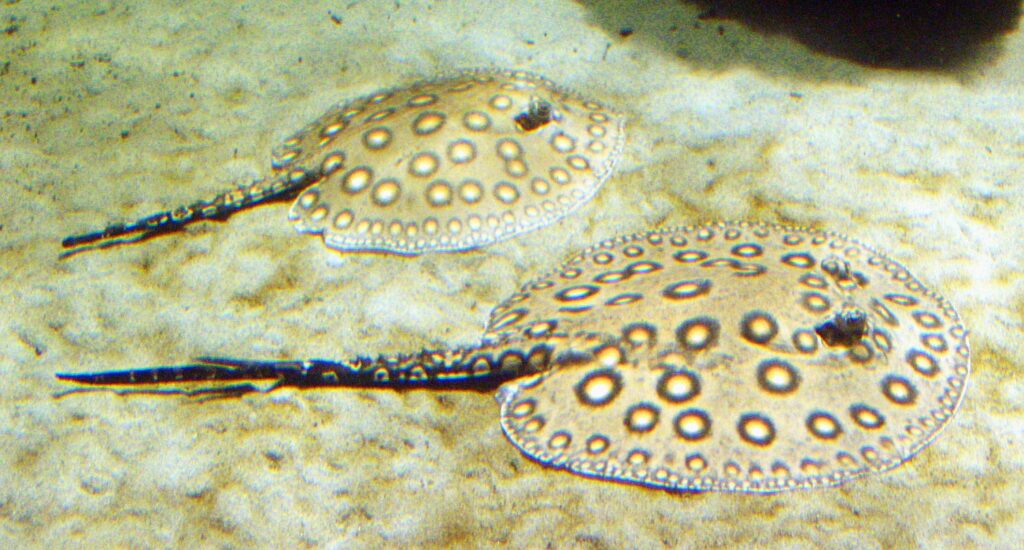
The Ocellate River Stingray or Motoro Stingray, Potamotrygon motoro, is the only freshwater aquarium fish whose aquarium-trade future is being discussed at the upcoming CITES CoP17 meeting. Image by Raimond Spekking, CC BY-SA 4.0
CITES CoP17, Johannesburg, South Africa, starts tomorrow. This is the 17th Conference of Parties meeting to be held, a meeting which has been held roughly every 2-3 years since the first CoP in 1976. CoP meetings are the time when changes to CITES listings for species are discussed and debated, culminating in the adoption of additions and revisions to the CITES appendices.
Among the many species up for discussion, three fish species noteworthy in the aquarium trade will be debated. The proposals include:
- Include the Ocellate River Stingray Potamotrygon motoro. in Appendix II, proposed by Bolivia
- Include the Clarion Angelfish, Holacanthus clarionensis, in Appendix II, proposed by Mexico
- Include the Banggai Cardinalfish, Pterapogon kauderni. in Appendix II, proposed by the European Union
An additional proposal may be of interest to some aquarists:
- Include the Family Nautilidae in Appendix II, proposed by Fiji, India, Palau and the United States of America
If listed, a species becomes difficult to trade without special permissions and paperwork and may be banned completely from sale into the European Union (EU).
Based on the released documentation, the CITES Secretariat has recommended to reject the listings for the Motoro Stingray (a freshwater species from South America) as well as recommending a similar rejection for the Clarion Angelfish. In the latter case, the Secretariat notes that, “Mexico may wish to consider including Holacanthus clarionensis in CITES Appendix III.”
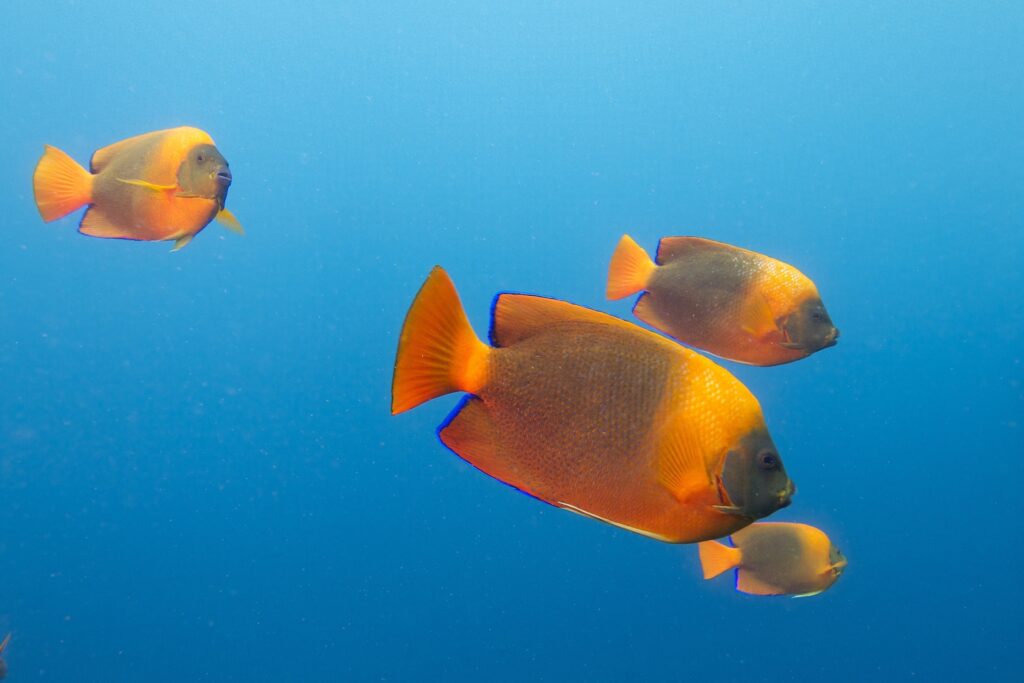
The Clarion Angelfish, Holacanthus clarionensis, is a somewhat rare species in the aquarium trade, typically selling for $2500 to $4000 per fish, and these days more commonly seen as a captive-bred offering out of Bali Aquarich. Image by Elias Levy, CC-BY-2.0
The CITES Secretariat’s recommendations include support for the listing of all nautiloids in Appendix II. This will likely have little impact on the aquarium trade in the species, which appears to be extremely limited.
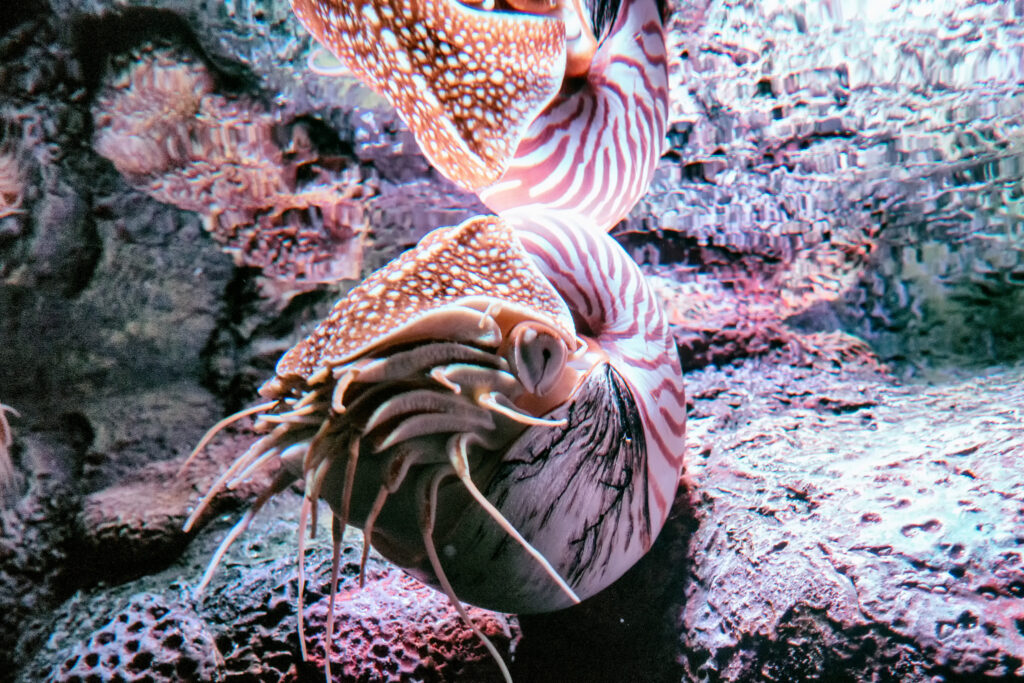
A Chambered Nautilus, on display at the Monterey Bay Aquarium. Image by Eric Kilby, CC-BY-SA-2.0
A listing of nautiloids will likely have little impact on the aquarium trade in the various species, which appears to be extremely limited based on information from AquariumTradeData.org, with never more than 200 Nautilus spp. being imported to the US in a given year, and usually significantly less.
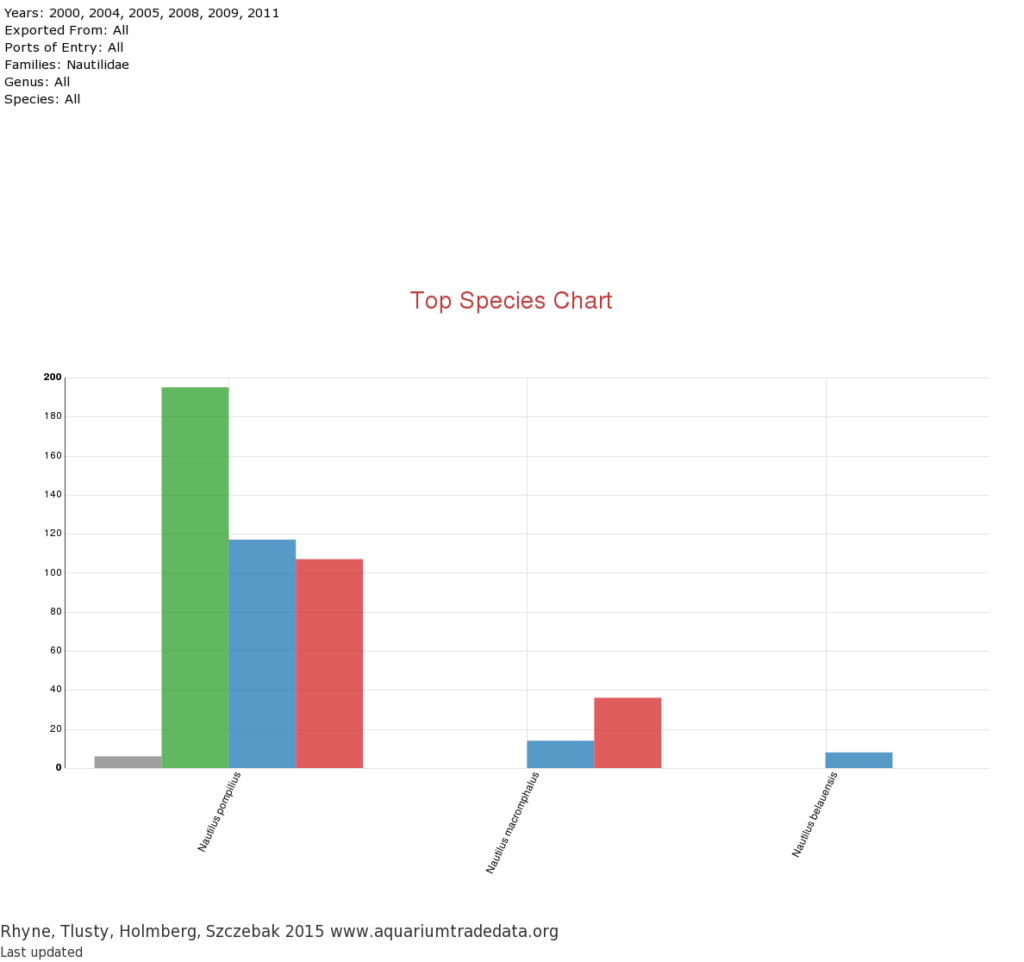
US import data on all nautiloid species from AquariumTradeData.org. Key: Gray = 2000, Green = 2008, Blue = 2009, Red = 2011.
It is the consideration of the the Banggai Cardinalfish for Appendix II listing that perhaps will garner the most attention from the aquarists, and this proposal currently has a recommendation to approve coming from the CITES Secretariat (it should be noted that the Secretariat’s recommendations are just that; they are not binding decisions already set).
What is CITES?
For any reader unfamiliar with CITES, the Convention on International Trade in Endangered Species of Wild Fauna and Flora, CITES.org includes a detailed introduction for review. This international agreement is currently voluntarily adhered to by 183 countries. CITES listings already play a role in the international trade of several groups of species traded for aquarium purposes, perhaps most notably including many corals and all seahorses.
Listings of a species, genus or family under CITES Appendices I, II or III, has various trade ramifications. Appendix I species essentially being off limits, Appendix II species having their trade controlled, and Appendix III with more minimal trade documentation requirements than Appendix II (view detailed explanations of Appendices on the CITES website).
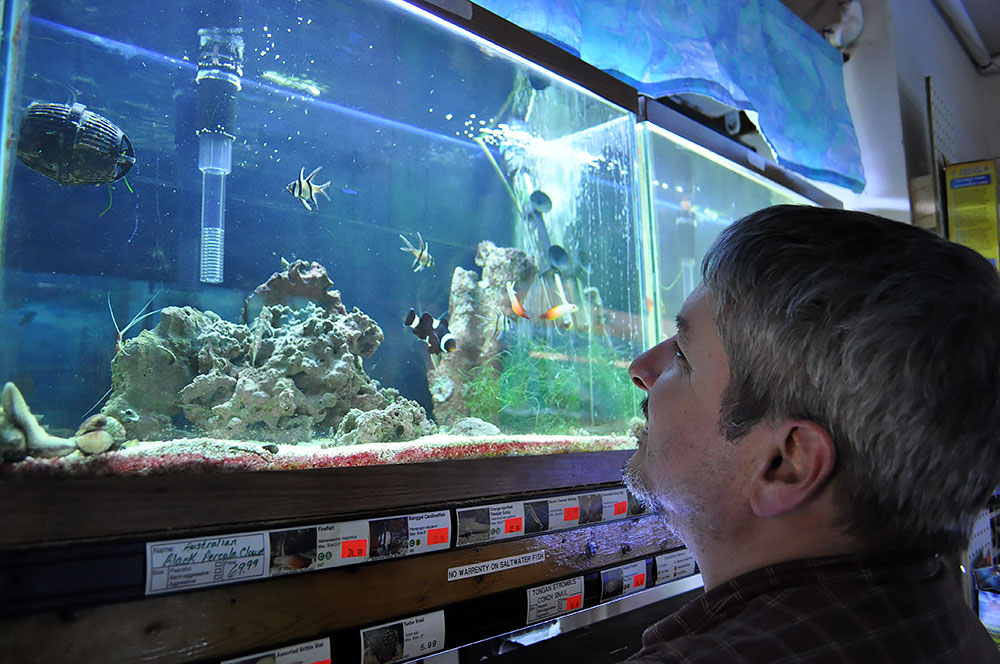
John Kamp at World of Fish in Duluth, MN, inspecting recently arrived Banggai Cardinalfish. The species remains a perennial favorite, generally in the top-10 species imported into the US.
IUCN, CITES, the ESA, and the Banggai Cardinalfish
The Banggai Cardinalfish was first proposed for CITES listing in Appendix II by the United States during CoP14, at the Hauge, Netherlands, in 2007. Just a few months prior, the Banggai Cardinalfish had been listed on the IUCN Red List as an Endangered Species, where it remains at this time (it’s noteworthy that the Red List does not have any effect on trade in a species). The proposal to list the Banggai under CITES in 2007 ultimately failed.
Since that time, the trade in wild Banggai Cardinalfish has continued, although since roughly 2013, it appears that in some markets, captive-bred Banggai Cardinalfish produce by large scale operations in Asia have potentially overtaken the bulk of the trade volume in the species. After review in 2015, at the start of 2016, the Banggai Cardinalfish was listed within the US under the Endangered Species Act (ESA) as Threatened, with the Final Rule becoming effective February 19th, 2016.
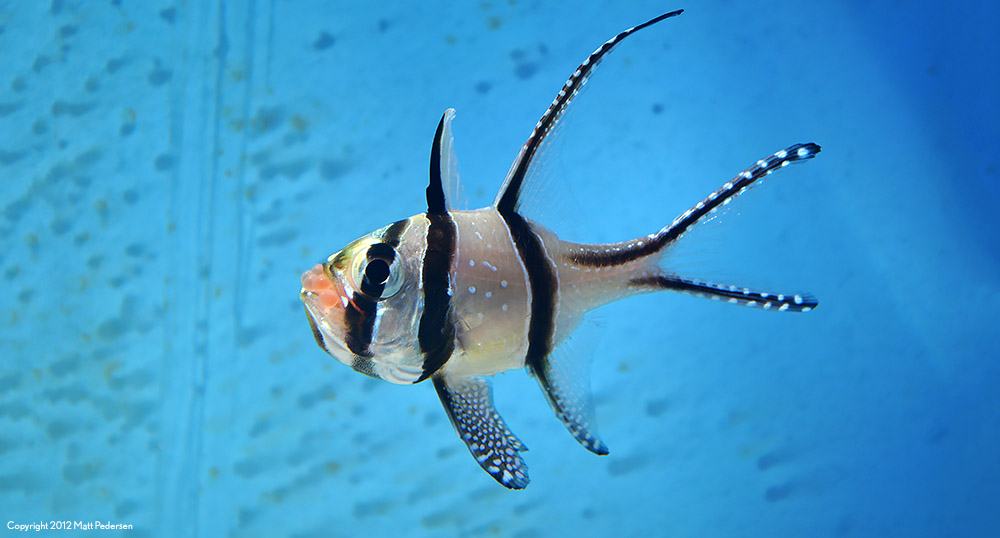
A male Pterapogon kauderni holding a clutch of freshly spawned eggs in his mouth; this popular species is known for their paternal mouthbrooding behavior.
The Reattempt to List the Banggai under CITES
With this latest proposal to list the Banggai under CITES, once again the debate over aquarium fisheries and the aquarium trade comes to the forefront, and not everyone is in agreement.
OATA, the Ornamental Aquatic Trade Association, is the organization representing the aquarium trade in the UK. OATA issued a position statement in opposition to the EU’s proposal to list the Banggai under Appendix II.
OATA beings by citing Indonesia’s ongoing opposition to the listing, something which was generally cited as part of the reason the 2007 proposal failed. “The proposal to list Banggai Cardinal fish on Appendix II is not supported by Indonesia, the only range country for the species. Indonesia considers that such a listing will do nothing to support their national management of the species.”
Furthermore, OATA notes that, “The proposal to put Banggai Cardinal fish on Appendix II is a repetition of an earlier failed listing attempt from 2007. However OATA believes that, although updated, the current proposal does not show any likely benefits of a listing. While the proposal indicates that there has been a continuing decline in Banggai Cardinal fish populations within its original distribution area in the Banggai Archipelago, it is unclear what the main factors for the decline are. There are other threats to the species such as habitat destruction which most likely are more significant than the trade, and that can be expected to increase if the trade incentive for protecting the species is lost.” [read the full position statement here]
Dr. Andrew Rhyne, a leading aquarium trade and aquaculture researcher and author of the paper Is sustainable exploitation of coral reefs possible? A view from the standpoint of the marine aquarium trade, differs in his opinion.
On the eve of CoP17, Rhyne wrote, “The only way forward for the trade in wild BCF [Banggai Cardinalfish] is for it to have a regulated trade. CITES does not prohibit trade, it does increase the burden for trade and for this species that burden is something that likely needs to be in place. Having a higher cost fish or entire shipment is the price that has to be paid for ensuring the unregulated trade in BCF is curtailed. The natural populations of this species have been greatly impacted by trade. There is no one that can suggest it hasn’t. There is overwhelming evidence that it’s natural range has been greatly impacted by trade. That is precisely the purpose of CITES. To allow trade but regulated trade. CITES has worked very well for seahorses and the aquarium trade. Hasn’t worked well for the CTM in seahorses.”
CoP17 runs through October 5th, so within the next two weeks, we’ll know which species and groups, if any, obtain new protections under CITES.
References:
CoP17 Species Proposals – https://cites.org/sites/default/files/eng/cop/17/WorkingDocs/E-CoP17-88-01-A1.pdf
CoP17 Banggai Cardinalfish Listing Proposal – http://ec.europa.eu/environment/cites/pdf/cop17/Pterapogon%20kauderni.pdf
CoP14 Banggai Cardinalfish Listing Proposal – https://www.cites.org/eng/cop/14/prop/E14-P19.pdf
OATA Position Statement – http://www.ornamentalfish.org/uncatogorized/oata-position-on-forthcoming-cites-meeting
Additional Reading:
Banggai Rescue Project: http://www.reef2rainforest.com/banggai-rescue-project/
For an in-depth look at the plight of the Banggai Cardinalfish, a limited number of copies of the highly praised book, Banggai Cardinalfish, the publication of the Banggai Rescue Project, are still available.
Talbot, Ret. Pedersen, M. and Wittenrich, M. (2013). Banggai Cardinalfish: A Guide to Captive Care, Breeding & Natural History hardcover ed. Available from Amazon and aquarium booksellers.
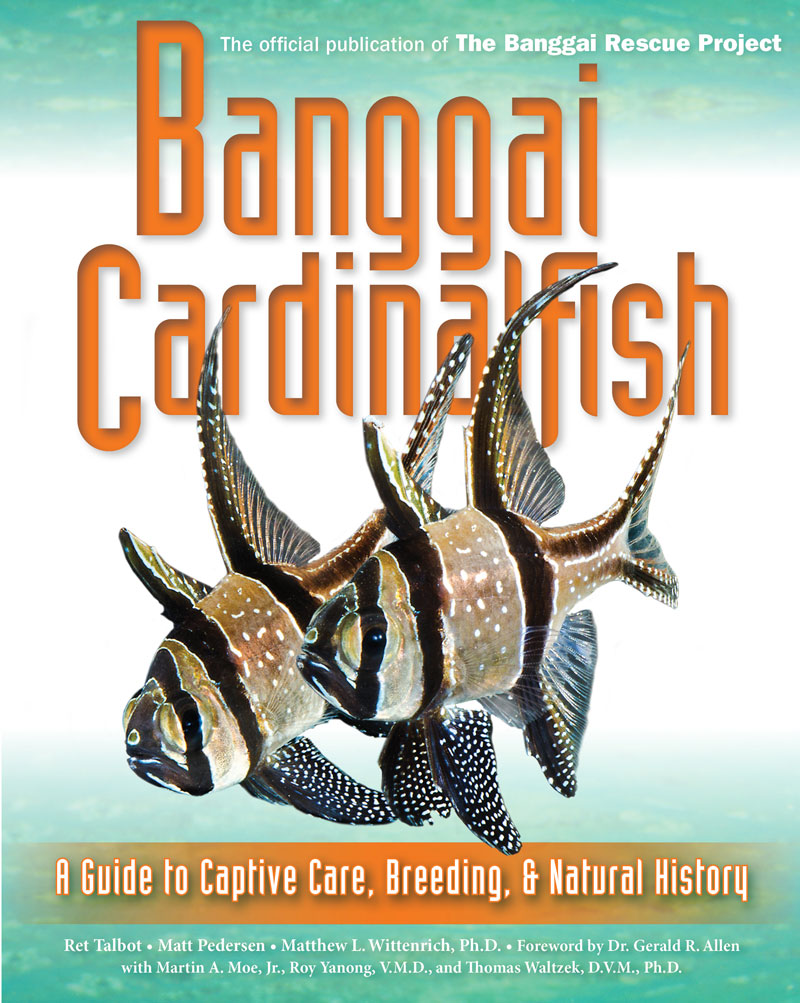
Banggai Cardinalfish, the book from Ret Talbot, Matt Pedersen and Dr. Matthew L. Wittenrich, investigating the past, present and future of this iconic and troubled aquarium fish.
Dealers: Contact Julian Sprung at Two Little Fishies for wholesale quantities.
Vagelli, A. 2001. The Banggai Cardinalfish: Natural History, Conservation, and Culture of Pterapogon kauderni. Wiley-Blackwell. Available from Amazon.





You forgot to post Dr. A. Vagelli’s book on Bangaii Cardinalfish.
It’s right there at the end – “Vagelli, A. 2001. The Banggai Cardinalfish: Natural History, Conservation, and Culture of Pterapogon kauderni. Wiley-Blackwell. Available from Amazon.”